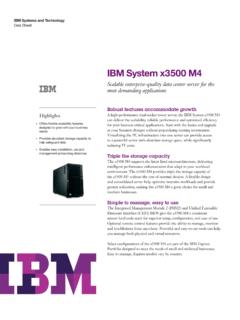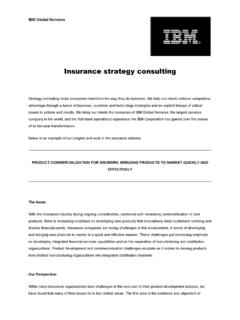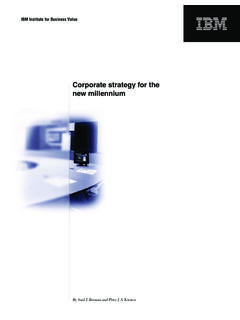Transcription of IBM Global Services eStrategy Report New rules bring ...
1 IBM Global ServicesIBM Global ServicesIBM Global ServicesIBM Global ServiceseStrategy ReporteStrategy ReporteStrategy ReporteStrategy ReportNew rules bring consumer and trade promotions to harsher lightNew rules bring consumer and trade promotions to harsher lightNew rules bring consumer and trade promotions to harsher lightNew rules bring consumer and trade promotions to harsher lightJuly 2001by Julian ChuNew accounting guidelines set forth by the Financial Accounting Standards BoardNew accounting guidelines set forth by the Financial Accounting Standards BoardNew accounting guidelines set forth by the Financial Accounting Standards BoardNew accounting guidelines set forth by the Financial Accounting Standards Boardover the past year will force consumer product manufacturers to classify much ofover the past year will force consumer product manufacturers to classify much ofover the past year will force consumer product manufacturers to classify much ofover the past year will force consumer product manufacturers to classify much oftheir consumer and trade promotion expenses as a reduction in revenue.
2 What aretheir consumer and trade promotion expenses as a reduction in revenue. What aretheir consumer and trade promotion expenses as a reduction in revenue. What aretheir consumer and trade promotion expenses as a reduction in revenue. What arethe strategic and operational implications of these changes for CPG firms?the strategic and operational implications of these changes for CPG firms?the strategic and operational implications of these changes for CPG firms?the strategic and operational implications of these changes for CPG firms?Note: The information presented in this Briefing reflects interpretation of FASB rulings byIBM business consultants. It was not prepared by a Certified Public Accountant andshould not be taken as guidance or advice with respect to the subject move for consistencyA move for consistencyA move for consistencyA move for consistencyThe Financial Accounting Standards Board (FASB) recently made several decisions thathave received relatively little attention in the marketplace, yet could have far-reachingimplications for consumer product in 2002, much, if not most, of the funds that manufacturers spend on consumerpromotions ( , coupons and rebates) as well as trade promotions ( , slotting fees see figure below for more details) can no longer be buried in COGS or the G&A , these amounts will need to be classified as a reduction in revenue.
3 In other words,they will come right off the manufacturer s top impetus for the FASB s actions was the wide variation in accounting practices amongmanufacturers both across and within product categories like consumer electronics andgroceries. The new rules are intended to standardize the way different companiesaccount for promotional expenses, allowing their financial statements to be comparedmore easily. Those companies that have engaged in significant promotional activity willConsumer and trade promotionsConsumer and trade promotionsConsumer and trade promotionsConsumer and trade promotions2see their officially reported size, in terms of revenues, substantively and how Wall Street will react to these changes is beyond the scope of thisbriefing. We focus instead on what strategic and operational implications may arise forconsumer packaged goods firms (CPGs) in particular, as the industry transitions to a newway of looking at consumer and trade of CPG trade promotionsOverview of CPG trade promotionsOverview of CPG trade promotionsOverview of CPG trade promotionsManufacturers offer Manufacturers offer various forms of value.
4 Various forms of value .. Slotting fees Buydowns Cooperative advertising programs Off-invoice discounts Favorable payment terms Market development funds Bracket return for retailer ..in return for retailer promises and and corporate level: Prioritize in merchandising plan Buy in advance of demand Set favorable prices Distribute new productsAt retail level: Assign favorable aisle and shelf placement ( , end caps) Include in store-level merchandising ( , ads, displays, coupons) Set favorable hopes of generating ..in hopes of generating incremental volume and profitincremental volume and profitGross incremental volumeCannibalization Pantry loading True incremental volume Additional volume from current customers New customersManufacturers offer Manufacturers offer various forms of value ..various forms of value .. Slotting fees Buydowns Cooperative advertising programs Off-invoice discounts Favorable payment terms Market development funds Bracket return for retailer.
5 In return for retailer promises and and corporate level: Prioritize in merchandising plan Buy in advance of demand Set favorable prices Distribute new productsAt retail level: Assign favorable aisle and shelf placement ( , end caps) Include in store-level merchandising ( , ads, displays, coupons) Set favorable hopes of generating ..in hopes of generating incremental volume and profitincremental volume and profitGross incremental volumeCannibalization Pantry loading True incremental volume Additional volume from current customers New customersSource: IBM Strategy & Change double whammyA double whammyA double whammyA double whammyThree separate, but related decisions were issued by the FASB recently, each dealingwith a different category of manufacturer promotions. In sum, CPG firms will need torevise the way they account for both consumer and trade promotions at essentially thesame time. While their bottom lines will not be directly affected, slow-growing CPG firmsConsumer and trade promotionsConsumer and trade promotionsConsumer and trade promotionsConsumer and trade promotions3will suddenly seem smaller than they used to be, and potentially even more sluggish interms of revenue FASB s rulings aim to establish consistent industrywide practices for the accountingof certain types of promotional activity.
6 Those that fall under the defined criteria must beclassified as reductions in revenue, not as cost of goods sold or marketing expenses. Amore detailed description of each decision Consumer sales incentivesConsumer sales incentivesConsumer sales incentivesConsumer sales incentives Going forward, promotions that enable consumers toeither a) receive a price reduction for a product at the point-of-sale, or; b) receive aprice reduction by submitting a whole or partial refund claim should be classified as areduction of revenue. This includes most coupons and rebate programs in use Time or volume-based incentives Time or volume-based incentives Time or volume-based incentives Time or volume-based incentives This ruling addresses promotions where thecustomer (who could be a distributor, retailer, or an end consumer) receives a rebateor refund if the customer reaches a specified cumulative level of purchases with thevendor, or remains a customer for a specified period of time.
7 This includes slottingfees or other considerations that are payable on a contingency basis, dependent onthe retailer achieving a specified level of purchases from the the future, CPGs must account for the potential rebate by systematically allocatingits cost to individual underlying transactions as a reduction in revenue. In other words,for a US$100 item where the customer can receive a 10 percent rebate once a certainvolume is reached, US$90 should be recorded as revenue and US$10 as a Trade promotionsTrade promotionsTrade promotionsTrade promotions The third ruling addresses a variety of considerations paid by amanufacturer to resellers of its products, be they cash payments or credits that canbe applied against amounts owed to the manufacturer. Reseller includes bothtypical retailers, including those that purchase products of the manufacturer from adistributor, and companies that use the manufacturer s products asinputs/components for their own offerings ( , a computer system assembler).
8 Examples of the promotional considerations covered by this ruling include:Consumer and trade promotionsConsumer and trade promotionsConsumer and trade promotionsConsumer and trade promotions4 Slotting feesSlotting feesSlotting feesSlotting fees Payments to obtain space on a retailer s store shelves, whetherphysical or virtual. These can include payments related to brand development or newproduct introduction ( , for favorable in-store positioning, end-cap placement, oradditional shelf space). These fees can be incurred (1) before the products are soldto the retailer, (2) on a regular schedule, or (3) periodically as negotiated between thetwo parties. Cooperative advertising programsCooperative advertising programsCooperative advertising programsCooperative advertising programs Where a manufacturer agrees to reimburse theretailer for a portion of the advertising costs incurred by the retailer. BuydownsBuydownsBuydownsBuydowns Where a manufacturer agrees to reimburse a retailer for shortfalls in thesales price received by the retailer for the manufacturer s , all buydowns and most slotting fees as described above should be recognizedas reductions in revenue.
9 Other trade promotions that should be treated in this mannerinclude off-invoice deductions and reimbursement of promotion-related retailer FASB ruling does make room for exceptions, in part due to strong pushback fromCPG and other manufacturers. In order to be classified as an expense, the promotionmust meet two conditions: a) the manufacturer receives an identifiable, sufficientlyseparable benefit in return for the consideration, and b) the manufacturer can reasonablyestimate the fair value of that instance, an advertising-related payment made by a CPG firm to a retailer can beclassified as an expense if the retailer provides documentation of that advertising (helpingto satisfy the first condition) and the manufacturer can quantify the fair market value of thebenefit gained from the and trade promotionsConsumer and trade promotionsConsumer and trade promotionsConsumer and trade promotions5 Summary of FASB rulings on consumer and trade promotionsSummary of FASB rulings on consumer and trade promotionsSummary of FASB rulings on consumer and trade promotionsSummary of FASB rulings on consumer and trade promotionsDate ofDate ofDate ofDate ofRulingRulingRulingRulingScope and New GuidelinesScope and New GuidelinesScope and New GuidelinesScope and New GuidelinesImplementatioImplementatioImpl ementatioImplementatioScheduleScheduleSc heduleScheduleConsumer SalesConsumer SalesConsumer SalesConsumer SalesIncentivesIncentivesIncentivesIncen tivesMay 2000 Record coupons, rebates.
10 And refundreduction in revenueQ1 2002 Time or Volume-Time or Volume-Time or Volume-Time or Volume-Based IncentivesBased IncentivesBased IncentivesBased IncentivesJan 2001 Allocate the cost of time orvolume- based cash rebate or refundprograms as a reduction in revenue foeach underlying transaction Includes contingently payableslotting feesQ2 2001 Trade PromotionsTrade PromotionsTrade PromotionsTrade Promotions Apr 2001 Recognize buydowns, most slottinfees, and some cooperative advertisinprograms as reduction in revenue Exceptions meeting certain criteri can be classified as expensesQ1 2002 Source: FASB EITF 00-14, EITF 00-22, and EITF drag on revenue growthPotential drag on revenue growthPotential drag on revenue growthPotential drag on revenue growthAs noted above, there is no impact on a CPG firm s net operating margins as a result ofthese accounting changes. However, since the cost of much, if not most, consumer andtrade promotions will henceforth be taken out of the top line, CPG executives mustconsider what impact these marketing activities will have on overall company revenuegrowth and financial market perceptions.










